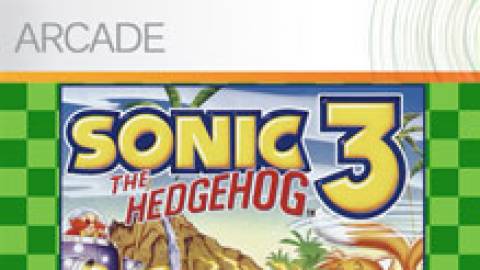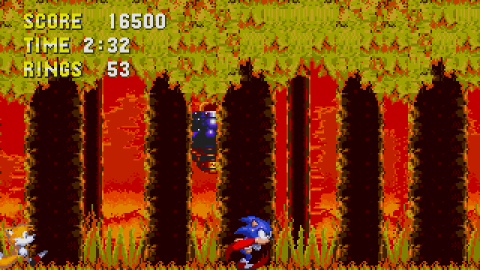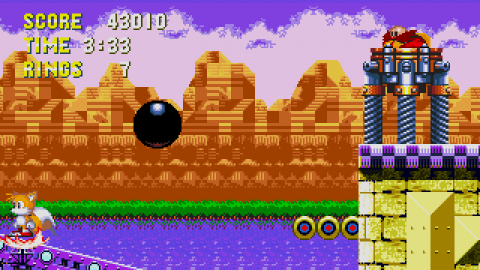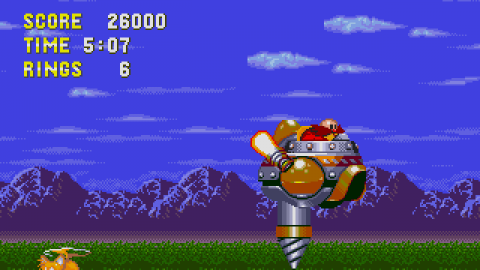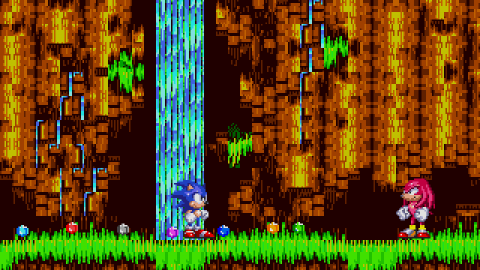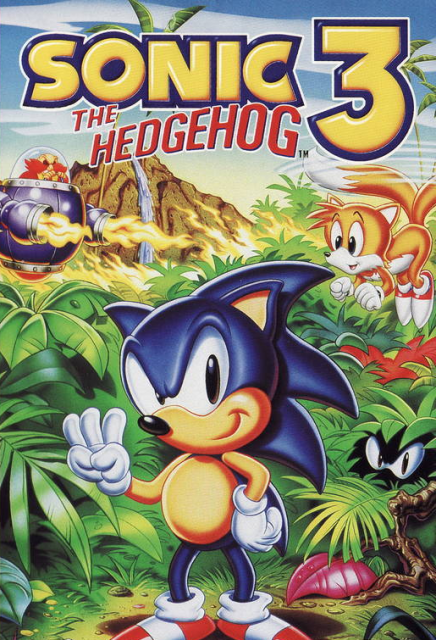Overview

After taking a year break, Sonic Team was back with a vengeance with Sonic the Hedgehog 3 in 1994. Much like the improvements of Sonic 2 over Sonic 1, Sonic 3 offers more content, more moves, and a new character - Knuckles the Echidna. There was so much new content that there was not enough time to finish it all in time for the game's release deadline; (a situation not unlike the 2006 Sonic the Hedgehog title) a large portion had to be cut and repackaged as Sonic & Knuckles later on in the same year, essentially allowing Sega to market and sell what was originally meant to be a single Sonic title as two separate, full priced games.
Like all Sonic games, the premise still remains the same: Get to the end of the level, while grabbing rings along the way, and destroying any enemy robots that may impede progress. Like Sonic 2, each world consists of two acts - the new twist being that act 1 ends on a "mini-boss", with act 2 ending with a typical encounter with the dastardly Doctor Eggman (aka Robotnik). Acts 1 and 2 also appear to be seamlessly and directly joined, now - rather than an Act ending, fading to black, and the next Act starting, Act 2 starts directly where Act 1 leaves off with no other transition to speak of.
Sonic 3 also introduces a new elemental shield system. Previously all Sonic games had one type of shield item Sonic could find that protected him from one attack before disappearing. In Sonic 3, shields still act this same same but now come in 3 distinct flavors, with each shield having a special move that is accessible by pressing the button while in the air. The shields are Fire, Bubble, and Electric. Each shield also protects Sonic from an element of that type: the Bubble Shield allows Sonic to stay underwater without having to breathe and bounce downwards mid-jump, the Fire Shield lets Sonic withstand fire attacks and as well as dash forward on a double jump and the Electric Shield reflects energy projectiles and attracts rings while offering a significantly higher double jump.
Another new addition to the series is the addition of mini bonus stages, a new type of bonus stage. Previously all Sonic games had special stages which allowed Sonic to collect chaos emeralds by playing some mini-games, Sonic 3 not only has an all-new type of special stages, which are now initiated by finding hidden special stage rings, but also adds optional mini bonus rounds, activated at checkpoints. These levels take multiple forms - For instance, one has Sonic bouncing up to a giant gumball machine which dispense various power-ups for Sonic and Tails Unlike a traditional special stage there is no reward for completing these stages other than the various power-ups that Sonic can attain during them. Sonic accesses Bonus Rounds by passing a starpost (i.e. checkpoint) with at least a certain amount of rings or more, whereas special stages are accessed by finding large rings hidden (and some not that hidden) throughout the levels.
Finally, due to the sheer size of the game and its massive levels (some of the largest in the franchise's history), Sonic 3 is the first Genesis Sonic game to implement SRAM for save game data, a feature conspicuously absent from Sonic The Hedgehog 2.
Plot
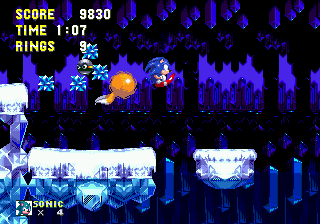
While taking a much needed rest and vacation with Sonic after destroying the Death Egg, Tails begins to detect odd energy readings on a jewel radar he had been tinkering with. The strangest part being it were receiving these energy readings from the middle of the ocean - a location in which there were no islands or land to speak of, and the type of energy it was picking up was characterized by a Chaos Emerald; but it would have to be a Chaos Emerald larger than any they had ever previously encountered.
On the other side of the beach, Sonic the Hedgehog discovers a strange type of ring he's never seen before. Being oddly well-versed in ancient civilizations for a Hedgehog, he recalls a story he once heard of a society, favored by the Gods, who were given a giant stone of great power as a gift. This stone of power became a focal point of the civilization's culture, but as is always the case, absolute power corrupts absolutely. It was not long until arguments broke out over who got to use the stone of power for what - arguments turned to wars, wars turned to bloodshed. This angered the Gods greatly, and from within the stone of power, a terrible force was unleashed that obliterated the civilization overnight. The island containing the civilization was banished to the sky as " Angel Island", and a lone guardian was posted to protect the stone to ensure nobody could ever misuse its powers again. Sonic and Tails, both excited by the prospect of a new adventure, set off in the direction of the mysterious energy readings.
What they discover is the remains of the Death Egg had, after plummeting out of the sky, landed on Angel Island - its incredible weight crashing down and sinking the island to sea level once again. Fearing Doctor Robotnik is seeking the Stone of Power for to revitalize the Death Egg, Sonic and Tails cautiously approach the mysterious island...
Zones
Each zone has 2 acts. Sonic The Hedgehog 3 has 12 acts in all.
- Angel Island Zone
- Hydrocity Zone
- Marble Garden Zone
- Carnival Night Zone
- Ice Cap Zone
- Launch Base Zone
Soundtrack
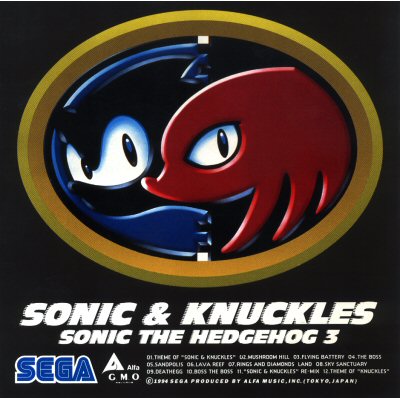
Sonic 1 and Sonic 2 composer Masato Nakamura is nowhere to be found in Sonic the Hedgehog 3. His replacements are a number of different people, most notably members from Michael Jackson's personal sound production team ( Brad Buxer, Doug Grisby III, Bobby Brooks, Darryl Ross and Geoff Grace). Early in the game's development cycle Sega had struck a deal with Jackson to lend his talents to the game's soundtrack, but Jackson was reportedly not happy with the sound quality produced by the Genesis, and on top of that, Sega downplayed his involvement when Michael became entangled in the molestation controversy. The remaining tracks in the game that were not composed by Michael Jackson's sound team were done by American composer Howard Drossin and Japanese composer Jun Senoue. Senoue would later become the leading musician for the Sonic franchise.
| 1. | Theme of "Sonic & Knuckles" | 01:15 |
| 2. | Mushroom Hill | 03:03 |
| 3. | Flying Battery | 02:55 |
| 4. | The Boss | 04:28 |
| 5. | Sandopolis | 02:57 |
| 6. | Lava Reef | 03:16 |
| 7. | Rings and Diamonds Land | 04:46 |
| 8. | Sky Sanctuary | 02:50 |
| 9. | Deathegg | 03:01 |
| 10. | Boss the Boss | 04:17 |
| 11. | "Sonic & Knuckles" Re-Mix | 11:46 |
| 12. | Theme of "Knuckles" | 01:36 |
Development History
After Sonic the Hedgehog 2 went on to become even more successful than the original Sonic the Hedgehog, Sega of Japan invited Yuji Naka and Sonic Team back to the land of the rising sun to begin work on Sonic the Hedgehog 3. Meanwhile, Sega Technical Institute in America began work on Sonic Spinball. Originally, Sonic Team wanted Sonic 3 to play off of the idea of being 3-Dimensional; an early gameplay test considered making the entire game in top-down, seen from an isometric view. Worried they would be changing the game too dramatically, they scrapped this concept and went back to making Sonic 3 a traditional side-scrolling Sonic game.
Like Sonic 1 and Sonic 2, an internal character design contest was held for the new character in Sonic 3. Winning this round was Takashi "Thomas" Yuda, for his Knuckles the Echidna design. The original design for Knuckles had him green in color, but after some focus testing, it was decided that red would be a more suitable hue.
Trivia
- Yuji Naka once again took inspiration from his favorite anime, Dragon Ball Z: the 3D Bonus Stages in this game were inspired by King Kai's miniature planet at the end of Snake Way.
- A number of tracks in this game, no doubt in relation to a certain American Pop-Star's involvement with music production, resemble Michael Jackson songs (for example, the song played over the credits bares considerable resemblance to the song "Stranger in Moscow").
- Though the concept of an isometric Sonic game was scrapped for Sonic the Hedgehog 3, Travelers Tales later revisited the concept in the form of Sonic 3D Blast.

 Genesis
Genesis Xbox 360 Games Store
Xbox 360 Games Store Wii Shop
Wii Shop PC
PC


